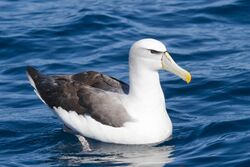Biology:Aequornithes
| Aequornithes | |
|---|---|

| |
| Shy albatross (Thalassarche cauta) | |
| Scientific classification | |
| Domain: | Eukaryota |
| Kingdom: | Animalia |
| Phylum: | Chordata |
| Class: | Aves |
| Clade: | Phaethoquornithes |
| Clade: | Aequornithes Mayr, 2010[3][4] |
| Clades | |
| |
Aequornithes (/iːkwɔːrˈnɪθiːz/, from Latin aequor, expanse of water + Greek ornithes, birds), or core water birds,[6] are defined as "the least inclusive clade containing Gaviidae and Phalacrocoracidae".[3]
The monophyly of the group is currently supported by several molecular phylogenetic studies.[7][8][9][10]
Aequornithes includes the clades Gaviiformes, Sphenisciformes, Procellariiformes, Ciconiiformes, Suliformes and Pelecaniformes. It does not include several unrelated groups of aquatic birds such as flamingos and grebes (Mirandornithes), shorebirds, gulls, and auks (Charadriiformes), or the Anseriformes(waterfowl).
Based on a whole-genome analysis of the bird orders, the kagu and sunbittern (Eurypygiformes) and the three species of tropicbirds (Phaethontiformes) together styled as the Eurypygimorphae are the closest sister group of the Aequornithes,[6] in a clade later named Phaethoquornithes.[11]
| Aequornithes |
| ||||||||||||||||||||||||||||||
Cladogram based on Burleigh, J.G. et al. (2015)[12] with some names after Sangster, G. & Mayr, G. (2021).[5]
References
- ↑ Slack, Kerryn E.; Jones, Craig M.; Ando, Tatsuro; Harrison, G.L. "Abby"; Fordyce, R. Ewan; Arnason, Ulfur; Penny, David (2006). "Early Penguin Fossils, plus Mitochondrial Genomes, Calibrate Avian Evolution". Molecular Biology and Evolution 23 (#6): 1144–1155. doi:10.1093/molbev/msj124. PMID 16533822. Supplementary Material
- ↑ Kuhl., H.; Frankl-Vilches, C.; Bakker, A.; Mayr, G.; Nikolaus, G.; Boerno, S. T.; Klages, S.; Timmermann, B. et al. (2020). "An unbiased molecular approach using 3'-UTRs resolves the avian family-level tree of life". Molecular Biology and Evolution 38: 108–127. doi:10.1093/molbev/msaa191. PMID 32781465.
- ↑ 3.0 3.1 Mayr, Gerald (2011). "Metaves, Mirandornithes, Strisores and other novelties – a critical review of the higher-level phylogeny of neornithine birds". Journal of Zoological Systematics and Evolutionary Research 49 (1): 58-76. doi:10.1111/j.1439-0469.2010.00586.x.
- ↑ Sangster, G.; Braun, E.L.; Johansson, U.S.; Kimball, R.T.; Mayr, G.; Suh, A. (2022). "Phylogenetic definitions for 25 higher-level clade names of birds". Avian Research 13: 100027. doi:10.1016/j.avrs.2022.100027.
- ↑ 5.0 5.1 Sangster, G.; Mayr, G. (2021). "Feraequornithes: a name for the clade formed by Procellariiformes, Sphenisciformes, Ciconiiformes, Suliformes and Pelecaniformes (Aves)". Vertebrate Zoology 71: 49–53. doi:10.3897/vertebrate-zoology.71.e61728.
- ↑ 6.0 6.1 Jarvis, E.D. (12 December 2014). "Whole-genome analyses resolve early branches in the tree of life of modern birds". Science 346 (6215): 1320–1331. doi:10.1126/science.1253451. PMID 25504713. Bibcode: 2014Sci...346.1320J.
- ↑ Hackett, S.J. (27 June 2008). "A phylogenomic study of birds reveals their evolutionary history". Science 320 (5884): 1763–1768. doi:10.1126/science.1157704. PMID 18583609. Bibcode: 2008Sci...320.1763H.
- ↑ Yuri, T. (2013). "Parsimony and model-based analyses of indels in avian nuclear genes reveal congruent and incongruent phylogenetic signals". Biology 2 (1): 419–444. doi:10.3390/biology2010419. PMID 24832669.
- ↑ Kimball, R.T. (December 2013). "Identifying localized biases in large datasets: A case study using the Avian Tree of Life". Mol Phylogenet Evol 69 (3): 1021–32. doi:10.1016/j.ympev.2013.05.029. PMID 23791948.
- ↑ Kuramoto, T. (2015). "Determining the Position of Storks on the Phylogenetic Tree of Waterbirds by Retroposon Insertion Analysis". Genome Biology and Evolution 7 (12): 3180–3189. doi:10.1093/gbe/evv213. PMID 26527652.
- ↑ Sangster, George; Braun, Edward L.; Johansson, Ulf S.; Kimball, Rebecca T.; Mayr, Gerald; Suh, Alexander (2022). "Phylogenetic definitions for 25 higher-level clade names of birds". Avian Research 13: 100027. doi:10.1016/j.avrs.2022.100027.
- ↑ Burleigh, J.G. (March 2015). "Building the avian tree of life using a large-scale, sparse supermatrix". Molecular Phylogenetics and Evolution 84: 53–63. doi:10.1016/j.ympev.2014.12.003. PMID 25550149.
Wikidata ☰ Q43657 entry
 |


